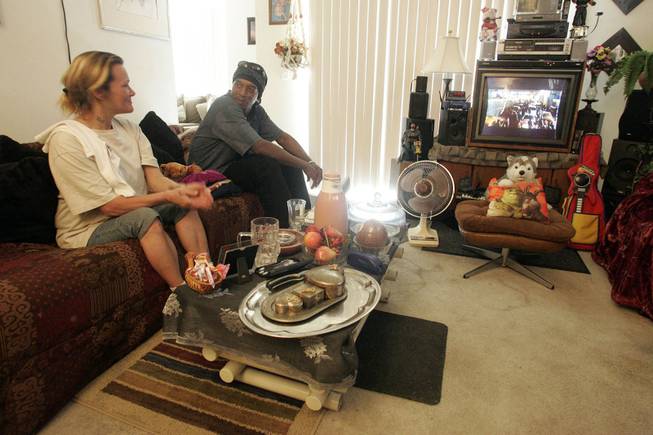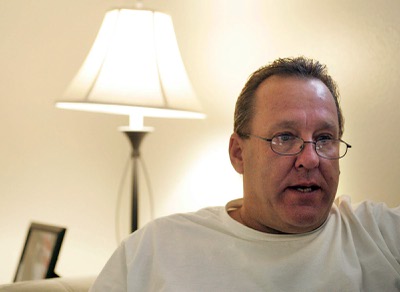
Michael Sumling chats with his friend Kerry Green in Sumling’s Horizon Crest apartment Friday. Sumling says he’s learned to take his medications even when he’s feeling “better.”
Tuesday, April 22, 2008 | 2 a.m.
It wasn’t exactly a crystal ball.
After careening through the nation’s alleys and jail cells for half his life, 47-year-old Michael Sumling saw his future one Fremont Street morning in a plastic bottle of Coke — with urine and a cigarette butt in it.
He spat out the sickly sweet liquid and almost vomited. He cursed his life. He knew it was time to stop living on the streets.
A first-of-its-kind project for the Las Vegas Valley, in the heart of what is called the homeless corridor, was the answer. Now in its fifth month, Horizon Crest on Owens Avenue is an unusual blend of 66 low-rent apartments for the poor and 12 apartments for the chronically homeless, those who have been on the street the longest.
The formerly homeless tenants have a case manager who is on-site Monday through Friday and a cell phone call away during the weekend. The idea is to get people off the streets and into housing without first forcing them to jump through such hoops as getting a job, completing a detox program or going to church — as is common in many other programs. The hope is that the anchor of an apartment, plus on-site or nearby help for addictions, mental illness and other problems, will be enough to keep people from going back to the streets.
The program’s goals are similar to those of a model used elsewhere called “housing first.” It’s based on the simple notion that the foremost need of homeless people is a place to close the door behind them at the end of every day, no strings attached and with lots of help readily available.
Nevada HAND, a housing developer, built the apartments for $11.5 million, using federal low-income housing tax credits as well as Las Vegas and state money. The formerly homeless tenants put 30 percent of their incomes toward the rent, with the remainder covered by county or state money. The tenants receive a rule book of sorts on entering the program, including requirements of weekly meetings and plans to develop daily routines leading to long-term housing.
The stakes are high: Experts estimate the chronically homeless cost society much more than their numbers suggest. The federal government defines this group as people with a physical or mental disability who have not had permanent housing for at least a year or four times in three years. Although they make up about 10 percent of the homeless population nationwide, the chronically homeless use about half the resources available for people on the street. The Las Vegas Valley’s homeless population is estimated at 12,000.
A Clark County study found that 113 chronically homeless people used $5.8 million of $10.9 million in local money available for helping the homeless from July 2002 to May 2005.
Sumling had been on the streets or in jail most of the time since leaving his home in Charleston, Miss., at the age of 16. By his count, he has been in 40 emergency rooms and clinics in dozens of states, whenever he was overrun by depression and the voices in his head. “They treat you for a few days and then throw you right back out on the street,” he says.
He attributes the voices to the beatings he says his father gave him growing up. He has Z-shaped strips of raised skin across his chest where he tried to stab himself once.
So he was never exactly ready for a job, or able to hold onto much of anything. He gets $637 a month in Social Security disability checks for his mental illness.
A few days after that bottle with Coke and urine, he was sitting in the Salvation Army’s day shelter. An announcement on the loudspeaker spoke of an event the next day to help the homeless.
“I was tired of being chased, of having nowhere to go,” he says.
He wandered among thousands of homeless men and women in the cavernous room at Cashman Center where the event was held. As he went from table to table, he ran across programs that mostly had those hoops. “They were telling me I had to go to church, instead of giving me a choice,” he recalls of one. “I wanted to get off the streets immediately.”
He wound up at a short-term program called New Genesis, where a caseworker from HELP of Southern Nevada told him about Horizon Crest. The main requirement was the ability to prove that he had been on the streets for a long time. That he could do.
Four months later, Sumling’s tall frame extends on a couch in a living room crammed with pictures and figurines he found in the trash, and he says in a soft voice that sleeping on a bed every night is “like a dream.”
He has a tote bag filled with Prozac and other pills. He made the mistake of assuming he was “better” two weeks ago and stopped taking those pills. Soon after, the voices came back, the memories, the wondering about whether life is worth living. He shows a spot on his wrist where he says he ran a knife across his skin. He called his caseworker from HELP, who soon showed up at his door. Because Sumling was not critically injured, the caseworker simply got him to find the tote bag.
Rodney Johnson lives downstairs from Sumling and has learned the same lesson as his neighbor: “No matter how good I feel, I cannot stop taking my medication,” he says.
His road into the streets differed greatly from Sumling’s. He is white, Sumling is black. He’s from the city — South Los Angeles; Sumling, from the rural South. The 52-year-old Johnson became a Marine in the 1970s and then had a job painting houses, a wife and children; most of his adult life, Sumling has been a loner with no income.
But they both have the same enemy — their own minds.
And they both have spent a long time shuttling through jails and hospitals that either punished them or merely kept them in holding patterns without permanently getting them off the streets or treating their underlying conditions.
Johnson says he was in a helicopter accident in the Marines and lives with pain, depression and post-traumatic stress disorder. The depression cost him his marriage, he said.
He came to Las Vegas in 2003 to seek work at the urging of a friend. He found himself jobless in 2006 when the clutch gave out on his 2003 GMC pickup truck. He lost his $850-a-month condo. He lived in his truck. He tried to get help from the Veterans Affairs Department.
The worst part of being homeless, Johnson says, is when you “wake up in the morning and you know nothing is going to happen in your life at all.”
One 100-degree day in June, he swallowed all his pills. Someone found him covered in sweat and with foam spilling out of his mouth. He was in University Medical Center on life support for a few weeks and then out on the street again. He sought help and wound up at Montevista Hospital, where a doctor steered him to HELP. That organization led him to Horizon Crest.
Johnson said the valley needs more programs like Horizon Crest for others he saw on the streets, and that more of the people who come in contact with the homeless, such as emergency room doctors or VA staff, should know about the programs that exist.
Of course, whatever leads people to live years on the street is not always undone in a few months. Three formerly homeless people have been evicted from Horizon Crest since the program began in December, and another two left on their own, Nevada HAND officials said.
Trish Stevens, case manager at Horizon Crest, says the evicted tenants “didn’t comply with the program.” That includes having too many visitors or failing to attend sessions she holds to help them develop skills such as looking for a job or taking care of their health.
So although there may not be many hoops to jump through for getting into the program, there are requirements for staying. “We give them every opportunity to get this right and we keep working with them, but sometimes they’re not ready for it,” Stevens says.
According to Sam Tsemberis, a psychologist who developed the housing first model in a New York City program called Pathways to Housing, putting conditions on housing — if you do this or don’t do this, you’ll lose your apartment — may not work with some of the hardest of the hard-core homeless. A study of his program showed that nearly nine of 10 chronically homeless people with mental illness stayed in housing for five consecutive years with round-the-clock help. Some have gone back to the streets and returned to his program later. Tsemberis calls his approach “structure with flexibility.”
He also noted that Horizon Crest makes an important contribution by placing the formerly homeless next door to people who aren’t coming off the streets. “That goes a long way toward giving people a sense of normalcy and dignity,” he says.
Horizon Crest appears to be working for Sumling and Johnson.
Sumling says resting in his apartment “is like being on a lake in a boat with a pillow and there’s nobody there to bother me. There’s no killin’, no ambulance, nobody bothers nobody. That’s what this place is like.”


Join the Discussion:
Check this out for a full explanation of our conversion to the LiveFyre commenting system and instructions on how to sign up for an account.
Full comments policy